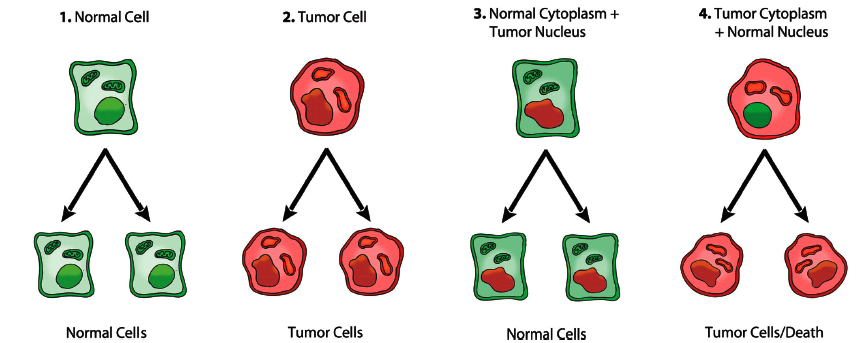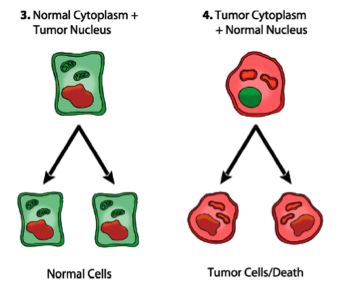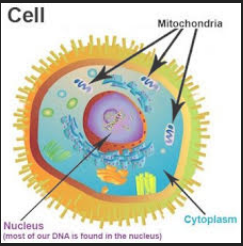This is the second of two Posts. In the first Post Thomas N. Seyfried Ph.D., in his down-to-earth no nonsense style,discusses his latest cancer research. https://www.youtube.com/watch?v=APwnkpD_BfI
For those who are suffering with or know someone who is suffering with cancer, my hope is that you watch the video and then present the video and the paper to your doctor.
Your knowledge may convince the doctor consider this approach that uses food and no radiation or chemotherapy.
NIH Paper: Nuclear Transfer Experiments disproved the gene theory of cancer, Dr. Seyfried’s scientific paper with the 243 supporting studies.
Source: https://www.ncbi.nlm.nih.gov/pmc/articles/PMC3941741/
This Post highlights some of the important points of Dr. Seyfried’s research paper.
Emerging evidence indicates that cancer is primarily a metabolic disease involving disturbances in energy production through respiration and fermentation. The genomic instability observed in tumor cells and all other recognized hallmarks of cancer are considered downstream epiphenomena of the initial disturbance of cellular energy metabolism.
Cancer growth and progression can be managed following a whole body transition from fermentable metabolites, primarily glucose and glutamine, to respiratory metabolites, primarily ketone bodies.
Introduction: A major impediment in the effort to control cancer has been due in large part to the confusion surrounding the origin of the disease.
Provocative question: does cancer arise from somatic mutations? Most of those who conduct academic research on cancer would consider it a type of somatic genetic disease where damage to a cell’s nuclear DNA underlies the transformation of a normal cell into a potentially lethal cancer cell.
Inconsistencies with a nuclear gene origin of cancer. Inconsistencies regarding the somatic nuclear gene theory of cancer come from nuclear/cytoplasmic transfer experiments between tumorigenic and non-tumorigenic cells. Several investigators showed that tumorigenicity is suppressed when cytoplasm from non-tumorigenic cells, containing normal mitochondria, is combined with nuclei from tumor cells. Moreover, the in vivo tumorigenicity of multiple human and animal tumor types is suppressed when the nucleus from the tumor cell is introduced into the cytoplasm of a nontumorigenic cell. Tumors generally did not form despite the continued presence of the tumor-associated mutations.
The conclusion that cancer can be best defined as a type of mitochondrial disease. The nuclear transfer studies are summarized in Figure 1, highlighting the role of the mitochondria in suppressing tumorigenesis.

Fig. 1. Role of the nucleus and mitochondria in the origin of tumors.This image summarizes the experimental evidence supporting a dominant role of the mitochondria in the origin of tumorigenesis as described previously. Normal cells are depicted in green with mitochondrial and nuclear morphology indicative of normal respiration and nuclear gene expression, respectively. Tumor cells are depicted in red with abnormal mitochondrial and nuclear morphology indicative of abnormal respiration and genomic instability. (1) Normal cells beget normal cells. (2) Tumor cells beget tumor cells. (3) Delivery of a tumor cell nucleus into a normal cell cytoplasm begets normal cells despite the persistence of tumor-associated genomic abnormalities. (4) Delivery of a normal cell nucleus into a tumor cell cytoplasm begets tumor cells or dead cells but not normal cells. The results suggest that tumors do not arise from nuclear genomic defects alone and that normal mitochondria can suppress tumorigenesis.
Respiratory insufficiency as the origin of cancer and the ‘Warburg effect’… there is only one common cause into which all other causes of cancer merge, the irreversible injuring of respiration.
The key points of Warburg’s theory are:
(i) insufficient respiration initiates tumorigenesis and ultimately cancer,
(ii) energy through glycolysis gradually compensates for insufficient energy through respiration,
(iii) cancer cells continue to ferment lactate in the presence of oxygen and
(iv) respiratory insufficiency eventually becomes irreversible (54–58).
Mitochondrial structure is intimately connected to mitochondrial function. …

Fig. 2. Typical ultrastructure of a normal mitochondrion and a mitochondrion from a human glioblastoma. Normal mitochondria contain elaborate cristae, which are extensions of the inner membrane and contain the protein complexes of the electron transport chain necessary for producing ATP through OxPhos. The mitochondrion from the glioblastoma (m) is enlarged and shows a near total breakdown of cristae (cristolysis) and an electronlucent matrix. The absence of cristae in glioblastoma mitochondria indicates that OxPhos would be deficient. The arrow indicates an inner membrane fold.
Cristae contain the proteins of the respiratory complexes and play an essential structural role in facilitating energy production through OxPhos.
It is obvious that mitochondrial function or OxPhos sufficiency cannot be normal in tumor cells that contain few if any mitochondria. Glycolysis and lactate fermentation would need to be upregulated in these tumor cells in order to compensate for the absence of OxPhos.
Connecting the links from respiratory insufficiency to cancer origin. The path from normal cell physiology to malignant behavior, where all major cancer hallmarks are expressed, is depicted in Figure 3.Any unspecific condition that damages a cell’s respiratory capacity but is not severe enough to kill the cell can potentially initiate thepath to a malignant cancer. Reduced respiratory capacity could arisefrom damage to any mitochondrial protein, lipid or mtDNA. Someof the many unspecific conditions that can diminish a cell’s respiratorycapacity thus initiating carcinogenesis include inflammation,carcinogens, radiation (ionizing or ultraviolet), intermittent hypoxia,rare germline mutations, viral infections and age.

Fig. 3. Mitochondrial respiratory dysfunction as the origin of cancer. Cancer can arise from any number of non-specific events that damage the respiratory capacity of cells over time. The path to carcinogenesis will occur only in those cells capable of enhancing energy production through fermentation (substrate level phosphorylation, SLP). Despite the shift from respiration to SLP the ΔG′ of ATP hydrolysis remains fairly constant at approximately −56 kJ indicating that the energy from SLP compensates for the reduced energy from OxPhos. The mitochondrial stress response or retrograde signaling will initiate oncogene upregulation and tumor suppressor gene inactivation that are necessary to maintain viability of incipient cancer cells when respiration becomes unable to maintain energy homeostasis. Genomic instability will arise as a secondary consequence of protracted mitochondrial stress from disturbances in the intracellular and extracellular microenvironment. Metastasis arises from respiratory damage in cells of myeloid/macrophage origin. The degree of malignancy is linked directly to the energy transition from OxPhos to SLP. This scenario links all major cancer hallmarks to an extrachromosomal respiratory dysfunction. The T signifies an arbitrary threshold when the shift from OxPhos to SLP might become irreversible.
Fig. 4. Timeline of events following expression of K-Ras. (K-ras controls cell proliferation). Please click this link for Figure 4 https://www.ncbi.nlm.nih.gov/pmc/articles/PMC3941741/
Can tumor somatic mutations arise as a downstream epiphenomenon of abnormal energy metabolism? Evidence indicates that a persistent retrograde response or mitochondrial stress response leads to abnormalities in DNA repair mechanisms and to the upregulation of fermentation pathways. Oncogene upregulation becomes essential for increased glucose and glutamine metabolism following respiratory impairment.
The metabolic waste products of fermentation can destabilize the morphogenetic field of the tumor microenvironment thus contributing to inflammation, angiogenesis and progression. Normal mitochondrial function is necessary for maintaining intracellular calcium homeostasis, which is required for chromosomal integrity and the fidelity of cell division. Aneuploidy can arise during cell division from abnormalities in calcium homeostasis. In this general picture, the abnormal genomic landscape seen in tumor cells is considered a downstream epiphenomenon of dysfunctional respiration and protracted oncogene-driven fermentation. In other words, the somatic mutations arise as effects rather than as causes of tumorigenesis. The nuclear transfer experiments support this view (Figure 1).
Exploiting mitochondrial dysfunction for the metabolic management of cancer.If cancer is primarily a disease of energy metabolism, then rationalstrategies for cancer management should be found in those therapiesthat specifically target tumor cell energy metabolism. These therapeuticstrategies should be applicable to the majority of cancers regardlessof tissue origin, as nearly all cancers suffer from a commonmalady, i.e. insufficient respiration with compensatory fermentation.
As glucose is the major fuel for tumor energy metabolism through lactate fermentation, the restriction of glucose becomes a prime target for management. It is well known that ketones can replace glucose as an energy metabolite and can protect the brain from severe hypoglycaemia. Hence, the shift in energy metabolism associated with a low carbohydrate, high-fat Ketogenic diet administered in restricted amounts (KD-R) can protect normal cells from glycolytic inhibition and the brain from hypoglycemia.
The metabolic shift from glucose metabolism to ketone body metabolism creates an anti-angiogenic, anti-inflammatory and proapoptotic environment within the tumor mass. The general concept of a survival advantage of tumor cells over normal cells occurs when fermentable fuels are abundant, but not when they are limited. Figure 5 illustrates the changes in whole body levels of blood glucose and ketone bodies (β-hydroxybutyrate) that will metabolically stress tumor cells while enhancing the metabolic efficiency of normal cells.
Implications for novel therapeutics. Once the whole body enters the metabolic zone described in Figure 5,relatively low doses of a variety of drugs can be used to further targetenergy metabolism in any surviving tumor cells. It is interestingthat the therapeutic success of imatinib (Gleevec) and trastuzumab(Herceptin) in managing BCR-ABL leukemia cells and ErbB2-positive breast cancers, respectively, is dependent on their ability to target signalling pathways linked to glucose metabolism.

Fig. 5. Relationship of circulating levels of glucose and ketones (β-hydroxybutyrate) to tumor management. The glucose and ketone values are within normal physiological ranges under fasting conditions in humans and will produce anti-angiogenic, anti-inflammatory and pro-apoptotic effects. We refer to this state as the zone of metabolic management. Metabolic stress will be greater in tumor cells than in normal cells when the whole body enters the metabolic zone. The values for blood glucose in mg/dl can be estimated by multiplying the mM values by 18. The glucose and ketone levels predicted for tumor management in human cancer patients are 3.1–3.8 mM (55–65 mg/dl) and 2.5–7.0 mM, respectively. These ketone levels are well below the levels associated with ketoacidosis (blood ketone values greater than 15 mmol). Elevated ketones will protect the brain from hypoglycemia.
Poff et al. also recently showed a synergistic interaction between the KD and hyperbaric oxygen therapy (HBO2T) (Figure 6). A dependency on glucose and an inability to use ketones for energy makes tumor cells selectively vulnerable to this therapy.
Besides drugs that target glucose, drugs that target glutamine can also be effective in killing systemic metastatic cancer cells.
The novelty of the metabolic approach to cancer managementinvolves the implementation of a synergistic combination of nutritionalketosis, cancer metabolic drugs and HBO2T. … This therapeutic strategy produces a shift in metabolic physiology that will not only kill tumor cells but also enhance the general health and metabolic efficiency of normal cells, and consequently the whole body. We view this therapeutic approach as a type of ‘mitochondrial enhancement therapy’.

Fig. 6. The KD and HBO2T (hyperbaric oxygen therapy) are synergistic in reducing systemic metastatic cancer in the syngeneic VM mouse model.
Advanced metastatic cancers can become manageable when their access to fermentable fuels becomes restricted. The metabolic shift associated with the KD-R involves ‘keto-adaptation’. However, the adaptation to this new metabolic state can be challenging for some people. The administration of ketone esters could conceivably enable patients to circumvent the dietary restriction generally required for sustained nutritional ketosis.
Definitions:
Angiogenic, formation of new blood vessels;
Apoptotic, programmed cell death;
Carcinogenesis, origin of cancer;
Cytoplasm, the material of a cell exclusive of that of the nucleus;
Epiphenomena, symptoms;
Extrachromosomal, outside the chromosome;
Fermentation, production of energy from a fuel;
Genome, hereditary factors;
Glioblastoma, A malignant tumor usually occurring in the cerebrum of adults;
Glycolysis, conversion of glucose resulting in energy;
Hypoglycaemia, Abnormally low levels of sugar (glucose) in the blood.
In vivo, within the living body;
OxPhos, Oxidative Phosphorylation (metabolic pathway)
Respiration, the oxidative process occurring within living cells by which the chemical energy of organic molecules is converted into energy involving the consumption of oxygen and the production of carbon dioxide and water as byproducts;
Tumorigenic, cause tumours relating to the development of tumours;
Source:https://medical-dictionary.thefreedictionary.com/
Abbreviations:ATP, adenosine triphosphate; HBO2T, hyperbaric oxygen therapy; KD, ketogenic diet; OxPhos, oxidative phosphorylation; ROS, reactive oxygen species; SLP, substrate level phosphorylation; TCA, tricarboxylic acid.
References: For the 243 Supporting Studies please go to the NIH website.
Source: Cancer as a metabolic disease: implications for novel therapeutics by Thomas N.Seyfried*, Roberto E.Flores, Angela M.Poff and Dominic P.D’Agostino https://www.ncbi.nlm.nih.gov/pmc/articles/PMC3941741/
I hope that these two Posts help you along the way to conquering cancer.
I invite you to Follow my Blog, Facebook or be added to my email distribution list. My focus is to maximize my physical performance and mental clarity, body composition, and most importantly overall health with a wholesome diet and exercise.
I will bring you compelling articles on Ketogenic and GAPS diets, the Super Slow High-Intensity Exercise Program and supplements.
To follow my Blog, please click the Follow button to receive an email when the next posting is available. Hint: You may have to click the Accept and Close button before follow is available.
I thrive on feedback. Please let me know you are interested in the content by clicking Like, Commenting or sending me a message or email about the Post.
If you wish to contact me by Email, please email lpolstra@bell.net using this form.
May you Live Long Healthy.
Yours truly,
Lydia Polstra
Email: lpolstra@bell.net
Facebook: https://www.facebook.com/2healthyhabits/


